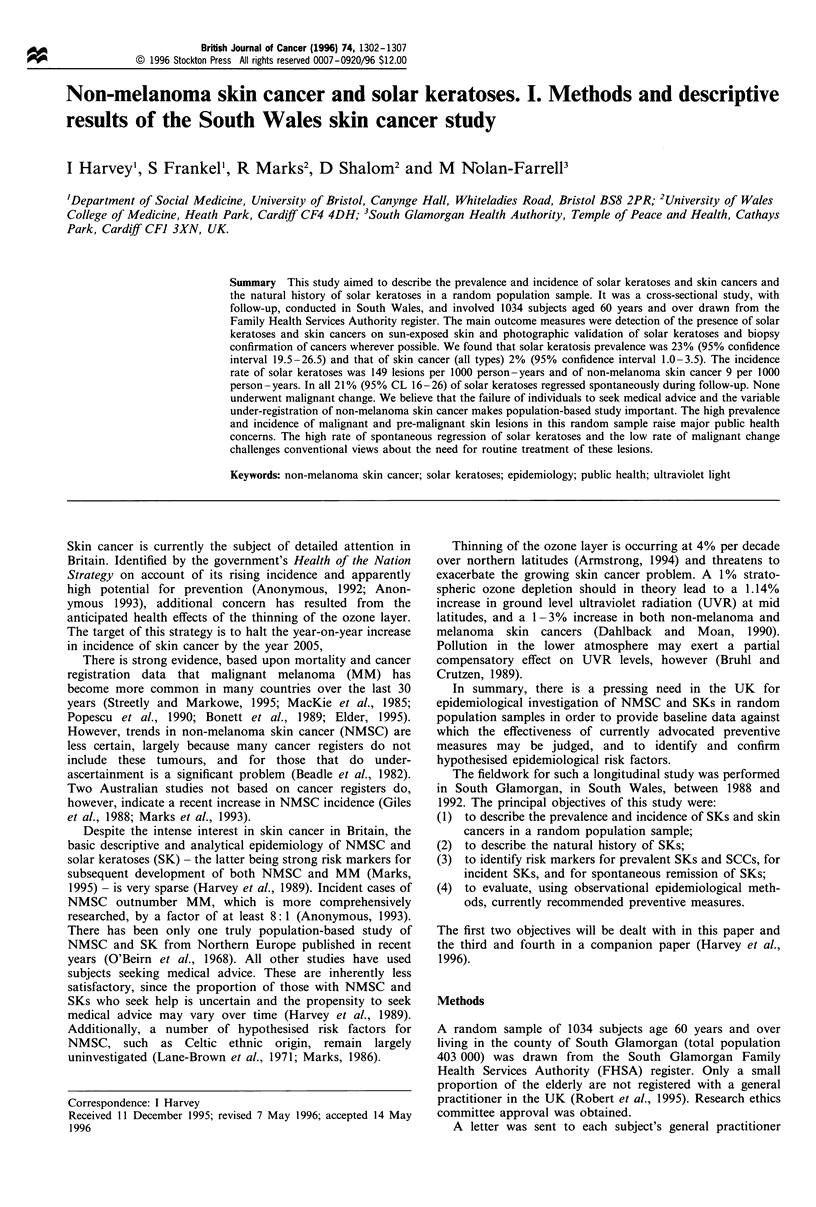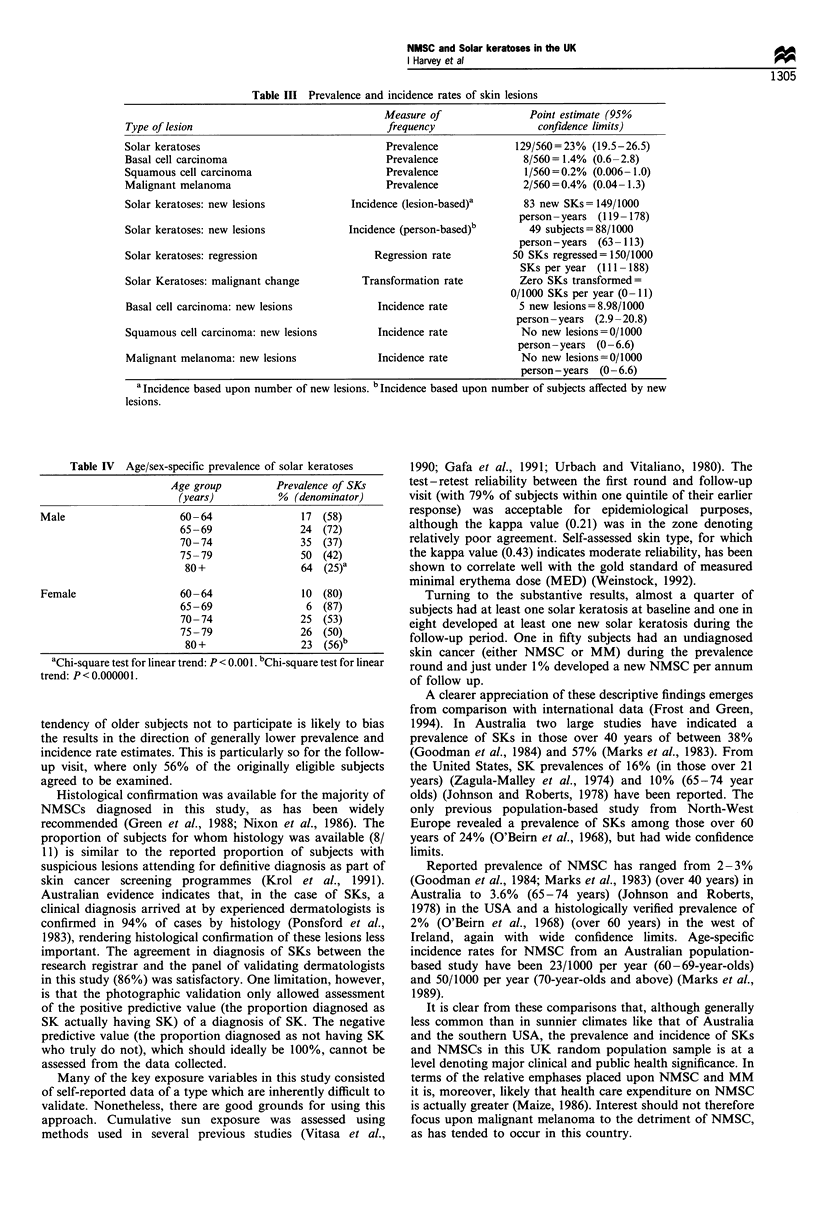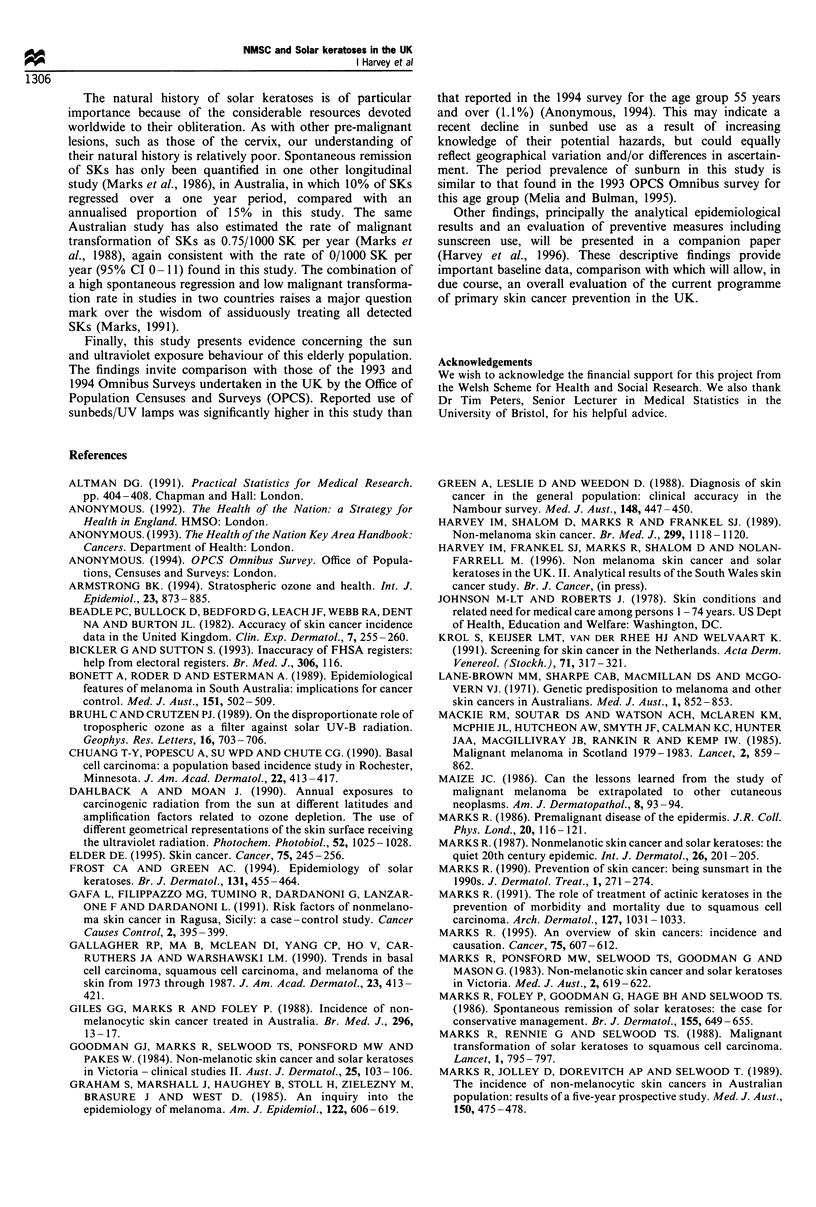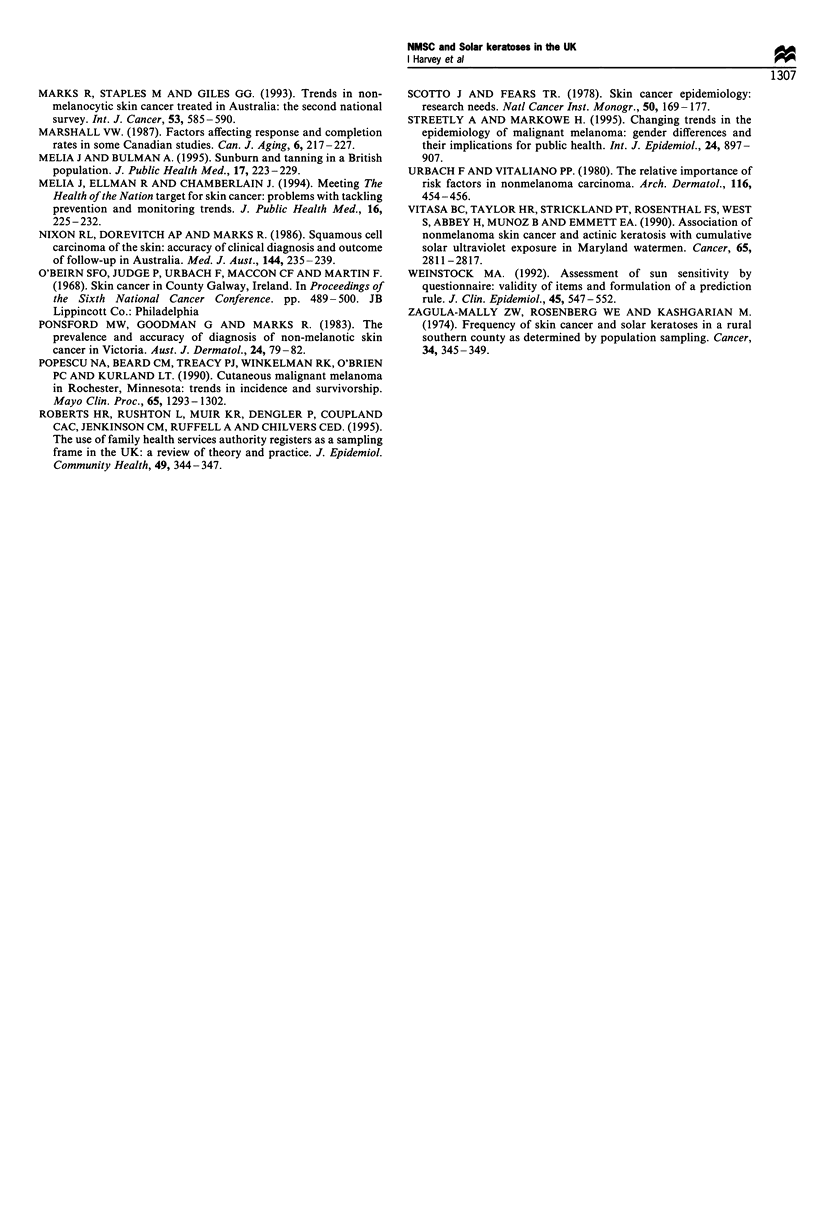Abstract
This study aimed to describe the prevalence and incidence of solar keratoses and skin cancers and the natural history of solar keratoses in a random population sample. It was a cross-sectional study, with follow-up, conducted in South Wales, and involved 1034 subjects aged 60 years and over drawn from the Family Health Services Authority register. The main outcome measures were detection of the presence of solar keratoses and skin cancers on sun-exposed skin and photographic validation of solar keratoses and biopsy confirmation of cancers wherever possible. We found that solar keratosis prevalence was 23% (95% confidence interval 19.5-26.5) and that of skin cancer (all types) 2% (95% confidence interval 1.0-3.5). The incidence rate of solar keratoses was 149 lesions per 1000 person-years and of non-melanoma skin cancer 9 per 1000 person-years. In all 21% (95% CL 16-26) of solar keratoses regressed spontaneously during follow-up. None underwent malignant change. We believe that the failure of individuals to seek medical advice and the variable under-registration of non-melanoma skin cancer makes population-based study important. The high prevalence and incidence of malignant and pre-malignant skin lesions in this random sample raise major public health concerns. The high rate of spontaneous regression of solar keratoses and the low rate of malignant change challenges conventional views about the need for routine treatment of these lesions.
Full text
PDF





Selected References
These references are in PubMed. This may not be the complete list of references from this article.
- Armstrong B. K. Stratospheric ozone and health. Int J Epidemiol. 1994 Oct;23(5):873–885. doi: 10.1093/ije/23.5.873. [DOI] [PubMed] [Google Scholar]
- Beadle P. C., Bullock D., Bedford G., Leach J. F., Webb R. A., Dent N. A., Burton J. L. Accuracy of skin cancer incidence data in the United Kingdom. Clin Exp Dermatol. 1982 May;7(3):255–260. doi: 10.1111/j.1365-2230.1982.tb02424.x. [DOI] [PubMed] [Google Scholar]
- Bonett A., Roder D., Esterman A. Epidemiological features of melanoma in South Australia: implications for cancer control. Med J Aust. 1989 Nov 6;151(9):502-4, 506-9. [PubMed] [Google Scholar]
- Brown M. M., Sharpe C. A., Macmillan D. S., McGovern V. J. Genetic predisposition to melanoma and other skin cancers in Australians. Med J Aust. 1971 Apr 17;1(16):852–853. doi: 10.5694/j.1326-5377.1971.tb87892.x. [DOI] [PubMed] [Google Scholar]
- Chuang T. Y., Popescu A., Su W. P., Chute C. G. Basal cell carcinoma. A population-based incidence study in Rochester, Minnesota. J Am Acad Dermatol. 1990 Mar;22(3):413–417. doi: 10.1016/0190-9622(90)70056-n. [DOI] [PubMed] [Google Scholar]
- Dahlback A., Moan J. Annual exposures to carcinogenic radiation from the sun at different latitudes and amplification factors related to ozone depletion. The use of different geometrical representations of the skin surface receiving the ultraviolet radiation. Photochem Photobiol. 1990 Nov;52(5):1025–1028. doi: 10.1111/j.1751-1097.1990.tb01820.x. [DOI] [PubMed] [Google Scholar]
- Elder D. E. Skin cancer. Melanoma and other specific nonmelanoma skin cancers. Cancer. 1995 Jan 1;75(1 Suppl):245–256. doi: 10.1002/1097-0142(19950101)75:1+<245::aid-cncr2820751310>3.0.co;2-7. [DOI] [PubMed] [Google Scholar]
- Frost C. A., Green A. C. Epidemiology of solar keratoses. Br J Dermatol. 1994 Oct;131(4):455–464. doi: 10.1111/j.1365-2133.1994.tb08544.x. [DOI] [PubMed] [Google Scholar]
- Gafà L., Filippazzo M. G., Tumino R., Dardanoni G., Lanzarone F., Dardanoni L. Risk factors of nonmelanoma skin cancer in Ragusa, Sicily: a case-control study. Cancer Causes Control. 1991 Nov;2(6):395–399. doi: 10.1007/BF00054300. [DOI] [PubMed] [Google Scholar]
- Gallagher R. P., Ma B., McLean D. I., Yang C. P., Ho V., Carruthers J. A., Warshawski L. M. Trends in basal cell carcinoma, squamous cell carcinoma, and melanoma of the skin from 1973 through 1987. J Am Acad Dermatol. 1990 Sep;23(3 Pt 1):413–421. doi: 10.1016/0190-9622(90)70234-9. [DOI] [PubMed] [Google Scholar]
- Giles G. G., Marks R., Foley P. Incidence of non-melanocytic skin cancer treated in Australia. Br Med J (Clin Res Ed) 1988 Jan 2;296(6614):13–17. doi: 10.1136/bmj.296.6614.13. [DOI] [PMC free article] [PubMed] [Google Scholar]
- Goodman G. J., Marks R., Selwood T. S., Ponsford M. W., Pakes W. Non-melanotic skin cancer and solar keratoses in Victoria--clinical studies II. Australas J Dermatol. 1984 Dec;25(3):103–106. doi: 10.1111/j.1440-0960.1984.tb00823.x. [DOI] [PubMed] [Google Scholar]
- Graham S., Marshall J., Haughey B., Stoll H., Zielezny M., Brasure J., West D. An inquiry into the epidemiology of melanoma. Am J Epidemiol. 1985 Oct;122(4):606–619. doi: 10.1093/oxfordjournals.aje.a114140. [DOI] [PubMed] [Google Scholar]
- Green A., Leslie D., Weedon D. Diagnosis of skin cancer in the general population: clinical accuracy in the Nambour survey. Med J Aust. 1988 May 2;148(9):447–450. doi: 10.5694/j.1326-5377.1988.tb139568.x. [DOI] [PubMed] [Google Scholar]
- Harvey I., Shalom D., Marks R. M., Frankel S. J. Non-melanoma skin cancer. BMJ. 1989 Nov 4;299(6708):1118–1120. doi: 10.1136/bmj.299.6708.1118. [DOI] [PMC free article] [PubMed] [Google Scholar]
- Krol S., Keijser L. M., van der Rhee H. J., Welvaart K. Screening for skin cancer in The Netherlands. Acta Derm Venereol. 1991;71(4):317–321. [PubMed] [Google Scholar]
- MacKie R. M., Smyth J. F., Soutar D. S., Calman K. C., Watson A. C., Hunter J. A., McLaren K. M., MacGillivray J. B., McPhie J. L., Rankin R. Malignant melanoma in Scotland 1979-1983. Lancet. 1985 Oct 19;2(8460):859–863. doi: 10.1016/s0140-6736(85)90126-6. [DOI] [PubMed] [Google Scholar]
- Maize J. C. Can the lesions learned from the study of malignant melanoma be extrapolated to other cutaneous neoplasms? Am J Dermatopathol. 1986 Apr;8(2):93–94. doi: 10.1097/00000372-198604000-00001. [DOI] [PubMed] [Google Scholar]
- Marks R. An overview of skin cancers. Incidence and causation. Cancer. 1995 Jan 15;75(2 Suppl):607–612. doi: 10.1002/1097-0142(19950115)75:2+<607::aid-cncr2820751402>3.0.co;2-8. [DOI] [PubMed] [Google Scholar]
- Marks R., Foley P., Goodman G., Hage B. H., Selwood T. S. Spontaneous remission of solar keratoses: the case for conservative management. Br J Dermatol. 1986 Dec;115(6):649–655. doi: 10.1111/j.1365-2133.1986.tb06644.x. [DOI] [PubMed] [Google Scholar]
- Marks R., Jolley D., Dorevitch A. P., Selwood T. S. The incidence of non-melanocytic skin cancers in an Australian population: results of a five-year prospective study. Med J Aust. 1989 May 1;150(9):475–478. doi: 10.5694/j.1326-5377.1989.tb136588.x. [DOI] [PubMed] [Google Scholar]
- Marks R. Nonmelanotic skin cancer and solar keratoses. The quiet 20th century epidemic. Int J Dermatol. 1987 May;26(4):201–205. doi: 10.1111/j.1365-4362.1987.tb00900.x. [DOI] [PubMed] [Google Scholar]
- Marks R., Ponsford M. W., Selwood T. S., Goodman G., Mason G. Non-melanotic skin cancer and solar keratoses in Victoria. Med J Aust. 1983 Dec 10;2(12):619–622. doi: 10.5694/j.1326-5377.1983.tb122724.x. [DOI] [PubMed] [Google Scholar]
- Marks R. Premalignant disease of the epidermis. The Parkes Weber lecture 1985. J R Coll Physicians Lond. 1986 Apr;20(2):116–121. [PMC free article] [PubMed] [Google Scholar]
- Marks R., Rennie G., Selwood T. S. Malignant transformation of solar keratoses to squamous cell carcinoma. Lancet. 1988 Apr 9;1(8589):795–797. doi: 10.1016/s0140-6736(88)91658-3. [DOI] [PubMed] [Google Scholar]
- Marks R., Staples M., Giles G. G. Trends in non-melanocytic skin cancer treated in Australia: the second national survey. Int J Cancer. 1993 Feb 20;53(4):585–590. doi: 10.1002/ijc.2910530410. [DOI] [PubMed] [Google Scholar]
- Marks R. The role of treatment of actinic keratoses in the prevention of morbidity and mortality due to squamous cell carcinoma. Arch Dermatol. 1991 Jul;127(7):1031–1033. [PubMed] [Google Scholar]
- Melia J., Bulman A. Sunburn and tanning in a British population. J Public Health Med. 1995 Jun;17(2):223–229. doi: 10.1093/oxfordjournals.pubmed.a043097. [DOI] [PubMed] [Google Scholar]
- Melia J., Ellman R., Chamberlain J. Meeting The Health of the Nation target for skin cancer: problems with tackling prevention and monitoring trends. J Public Health Med. 1994 Jun;16(2):225–232. doi: 10.1093/oxfordjournals.pubmed.a042961. [DOI] [PubMed] [Google Scholar]
- Nixon R. L., Dorevitch A. P., Marks R. Squamous cell carcinoma of the skin. Accuracy of clinical diagnosis and outcome of follow-up in Australia. Med J Aust. 1986 Mar 3;144(5):235–239. [PubMed] [Google Scholar]
- Ponsford M. W., Goodman G., Marks R. The prevalence and accuracy of diagnosis of non-melanotic skin cancer in Victoria. Australas J Dermatol. 1983 Aug;24(2):79–82. doi: 10.1111/j.1440-0960.1983.tb00256.x. [DOI] [PubMed] [Google Scholar]
- Popescu N. A., Beard C. M., Treacy P. J., Winkelmann R. K., O'Brien P. C., Kurland L. T. Cutaneous malignant melanoma in Rochester, Minnesota: trends in incidence and survivorship, 1950 through 1985. Mayo Clin Proc. 1990 Oct;65(10):1293–1302. doi: 10.1016/s0025-6196(12)62140-5. [DOI] [PubMed] [Google Scholar]
- Roberts H. R., Rushton L., Muir K. R., Dengler R., Coupland C. A., Jenkinson C. M., Ruffell A., Chilvers C. E. The use of family health services authority registers as a sampling frame in the UK: a review of theory and practice. J Epidemiol Community Health. 1995 Aug;49(4):344–347. doi: 10.1136/jech.49.4.344. [DOI] [PMC free article] [PubMed] [Google Scholar]
- Scotto J., Fears T. R. Skin cancer epidemiology: research needs. Natl Cancer Inst Monogr. 1978 Dec;(50):169–177. [PubMed] [Google Scholar]
- Streetly A., Markowe H. Changing trends in the epidemiology of malignant melanoma: gender differences and their implications for public health. Int J Epidemiol. 1995 Oct;24(5):897–907. doi: 10.1093/ije/24.5.897. [DOI] [PubMed] [Google Scholar]
- Vitaliano P. P., Urbach F. The relative importance of risk factors in nonmelanoma carcinoma. Arch Dermatol. 1980 Apr;116(4):454–456. [PubMed] [Google Scholar]
- Vitasa B. C., Taylor H. R., Strickland P. T., Rosenthal F. S., West S., Abbey H., Ng S. K., Munoz B., Emmett E. A. Association of nonmelanoma skin cancer and actinic keratosis with cumulative solar ultraviolet exposure in Maryland watermen. Cancer. 1990 Jun 15;65(12):2811–2817. doi: 10.1002/1097-0142(19900615)65:12<2811::aid-cncr2820651234>3.0.co;2-u. [DOI] [PubMed] [Google Scholar]
- Weinstock M. A. Assessment of sun sensitivity by questionnaire: validity of items and formulation of a prediction rule. J Clin Epidemiol. 1992 May;45(5):547–552. doi: 10.1016/0895-4356(92)90104-u. [DOI] [PubMed] [Google Scholar]
- Zagula-Mally Z. W., Rosenberg E. W., Kashgarian M. Frequency of skin cancer and solar keratoses in a rural southern county as determined by population sampling. Cancer. 1974 Aug;34(2):345–349. doi: 10.1002/1097-0142(197408)34:2<345::aid-cncr2820340219>3.0.co;2-0. [DOI] [PubMed] [Google Scholar]


